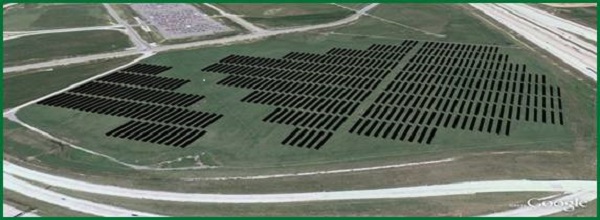Indiana is a state in desperate need of some renewable energy – according to industry data, coal now provides a whopping 86 percent of its electricity. The solar power array now going up on airport land in Indianapolis might not move that number a whole lot, but it is an impressive step in the right direction.
In planning for nearly two years – apparently it takes a lot of “pre-development activities” and “permitting and approvals” to do a 75-acre project like this – the 12-megawatt array that officially broke ground last week at IND will dwarf any other North American airport project, the developers said, including the 8 MW of capacity installed at Denver and the 5.4 MW in Phoenix.

Everyone involved – the city, the companies doing the project, the utility getting the power and the airport – called themselves a winner with this project. For example, Robert Duncan, executive director of the Indianapolis Airport Authority, said:
Hosting the largest airport-based solar farm in the country supports both environmental and economic sustainability at the Indianapolis International Airport. Through this public-private partnership, we are able to create a use for otherwise undevelopable land, benefit from a new source of non-airline revenue, increase the tax revenues we generates for local municipalities, and add to the many ways we incorporate sustainability into airport operations.
The solar projects at Indianapolis and Denver and elsewhere are backing up a report from the U.S. Department of Agriculture that promoted the idea of using airport open-space to contribute power to the grid. Some of these spaces are off-limits as sensitive habitat, but that’s not always the case. And it doesn’t always have to be solar that’s the renewable in play.
“Some available grasslands at airports have the potential to spur the type of innovation we need to build American-made, homegrown biofuels and biobased products that will help to break our dependence on foreign oil and move our nation toward a clean energy economy,” Agriculture Secretary Tom Vilsack said when that report came out last year.
“Converting airport grasslands to biofuel, solar or wind production not only provides more environmentally-sound alternative energy sources for our country, but may also increase revenue for airports and reduce the local abundance of potentially hazardous wildlife to aircraft.
The IND Solar Farm, as it has been dubbed, is expected to be producing juice sometime in the middle of the year. The developers say it will generate “15 million kilowatt hours of electric energy annually, enough to power more than 1,200 average American homes for a year.”